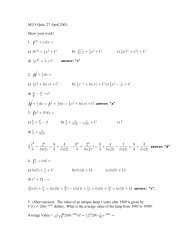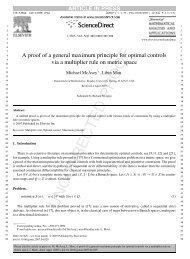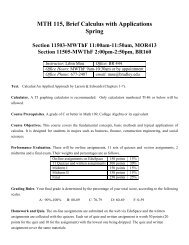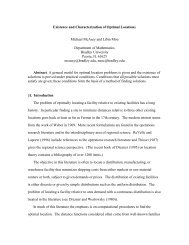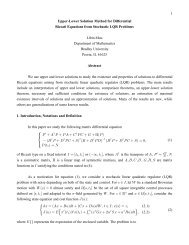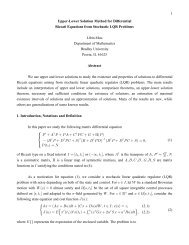1 General Algebraic and Differential Riccati ... - Bradley Bradley
1 General Algebraic and Differential Riccati ... - Bradley Bradley
1 General Algebraic and Differential Riccati ... - Bradley Bradley
Create successful ePaper yourself
Turn your PDF publications into a flip-book with our unique Google optimized e-Paper software.
1<strong>General</strong> <strong>Algebraic</strong> <strong>and</strong> <strong>Differential</strong><strong>Riccati</strong> Equations from Stochastic LQR ProblemLibin MouDepartment of Mathematics<strong>Bradley</strong> UniversityPeoria, IL 61625Abstract. In this paper we consider a class of matrix <strong>Riccati</strong> equations arising from stochasticLQR problems. We prove a monotonicity of solutions to the differential <strong>Riccati</strong> equations, whichleads to a necessary <strong>and</strong> sufficient condition for the existence of solutions to the algebraic <strong>Riccati</strong>equations. In addition, we obtain results on comparison, uniqueness, stabilizability <strong>and</strong> approximationfor solutions of the algebraic <strong>Riccati</strong> equations.§ 1. IntroductionThe following differential <strong>Riccati</strong> equation has been studied in [12] by using the method ofupper <strong>and</strong> lower solutions.Ú w XXÝ T €E T€TE€G TG€ K € CaTbX X XX " X XÛ aF T€HTG€WbaV€HTHb aF T€HTG€Wbœ!ßÝÜ T a>b œR,"(1)where E is the transpose of E, T œ.>, R is a symmetric matrix, C is a linear map of symmetricmatrices, <strong>and</strong> EßFßGßHß K ßV <strong>and</strong> W are bounded <strong>and</strong> measurable matrix functions with appropriatedimensions. The main results in [12] include an interpretation of upper <strong>and</strong> lower solutions,comparison theorems, an upper-lower solution theorem, necessary <strong>and</strong> sufficient conditions forexistence of solutions, an estimation of maximal existence intervals of solutions <strong>and</strong> an approximationof solutions.X w .T(1):This paper is a continuation ofXXE T€TE€G TG€ K € CaTb[12]. The focus here is the algebraic equation associated withXX X X X XaF T€HTG€WbaV€HTHb aF T€HTG€Wbœ! ,"(2)where EßFßGßHßK ßV <strong>and</strong> W are constant matrices with appropriate dimensions; see (5) below.The inclusion of the term C is important to stochastic control problems with Markovianjumping noises <strong>and</strong> differential game problems with state-dependent noises; see [18] <strong>and</strong> [11], forexample.Equation (2) with C œ! becomesXXE T€TE€G TG€ KXX X X X XaF T€HTG€WbaV€HTHb aF T€HTG€Wbœ! ."(3)Equation (3) arises from the following stochasticlinear quadratic regulator ( LQR) problem of infinite-
3Denote ’ 8 ‘8‚8 XXœ eT ÀT œTf, where T is the transpose of T. We write Q " Q#8 8 8( Q" žQ# ) if Q" Q# ’ is a positive semidefinite (definite). For a map C À ’ Ä ’ we writeC ! if CaQ b ! for each Q ." " !Assumption. We assume that EßFßGßHßKßVßW <strong>and</strong> R in equations (1), (2) <strong>and</strong> (3) are constantmatrices <strong>and</strong> C À ’ 8 Ä ’8 is a linear map, which satisfy8‚8 8‚5 8XEßG ‘ àFßHßW ‘ àV ’ 5 ; K, R ’ ; C 0 Þ(5)For a Hilbert space — <strong>and</strong> an interval M, P_ aMß—b is the space of all bounded <strong>and</strong> measurable"ß_ _ w _functions from M to —. Furthermore, we define P aMß— b œÖT P aMß— bßT P aMß — b×ÞThesolution T to (1) is assumed to be in P "ß_ aMß’ 8 b. Since all matrices in (1) are constant, a solution Ton M is actually smooth. The solution T to (2) <strong>and</strong> (3) is assumed to be in ’ 8 , which may beconsidered as a constant solution to the associated differential equation.As in [12], we abbreviate (1), (2) <strong>and</strong> (3) asÚ T w € LQaT b€ CaTb œ!ß T a> " b œ Rß (1)Û LQaT b€ CaTbœ!ß(2)Ü LQaTbœ!ß(3)where LQaTb œK€ L aTbQaTb <strong>and</strong>XXL aTbœE T€TE€G TG,œQ a bX XaF T€HTG€Wba XX " X XT œV€HTHb aF T€HTG€Wb(6)XWe remark that Q aTb <strong>and</strong> LQ aTbmake sense even if V€HTH is singular. To see this, weintroduce the following notationsX X XeaTb œV€HTH, faTbœ F T€HTG€W. (7)"e f e^a b œ a T b a T b if a T b is nonsingular,T œ€eaTb faTb if eaTbis singular,(8)€where eaTb is the pseudoinverse of eaTb. Recall that any matrix Q has a unique Moore-Penrosepseudoinverse Q € with the following properties (see [14] <strong>and</strong> [1]).€ € € €QQ QœQßQ QQ œQ . (9)8 € 8 € €If Q ’ , then Q ’ , <strong>and</strong> QQ œQ Q.Q€! if <strong>and</strong> only if Q !.€Although ^aTb œ eaTb faTbalways exists, but it may not be bounded nor satisfyfaTb œ eaTb^aT b(10)on the interval M. We recall some definitions in [12]. A function TP "ß_ aMß’ 8 b is said to be feasibleif ^ aTb P _ aMß‘5‚8 b <strong>and</strong> (10) holds . Afunction O P _ aMß‘5‚8 b is called a feedback matrixassociated with TP"ß_ aMß’ 8 wb if it satisfies faTb œ eaTbO.The set of all such O= is denoted by
4_ 5‚8ŠaTb. Suppose ^aTb P aMß‘ b, then T is feasible if <strong>and</strong> only if ŠaTb Ág, <strong>and</strong> in this case,XXQ aTbœ ^aTb eaTb^aTb œO eaTbO,(11)for each OŠaTb; see [12] for proof. In other words, Q aTbis well-defined by (11) whenever T isfeasible.If T ’ 8 , then T is feasible as long as (10) holds. The term "feasible" is consist with thatdefined in [23] for the associated semidefinite programming problem.Definition 1. T P"ß_ aMß’ 8 bis a solution (upper solution, lower solution) to (1) ifLQaTb€ L Q aT b€ CaTbœ! ( Ÿ! , !ßT ) a> b œR ( R,ŸRÑÞAn upper or lower solution is strict if one of the inequalities is strict. Similarly, T’ 8 is a solution(upper, lower solution) to (2) if L QaT b€ CaTbœ! ( Ÿ! , !, respectively).Upper <strong>and</strong> lower solutions can be interpreted in terms of the well-definedness of the LQRProblem (4). Let P# 5 (same as P# 8 ?a‘ bYa‘b in [1]) be space of ‘ 5 -valued processes ? on Ò!ß_Ñ thatare adapted to the 5 -field generated by [ ab > such that I' _ #!l?l .> _(square-integrable). Each? P# a‘ 5 b is an open-loop control. We say that ? P# a‘5 b is ms-stabilizing if the solution B toequation (4.2) satisfies IelBab> l # f Ä! as >Ä_ . The state equation (4.2) is stabilizable if thereexists a feedback matrix O ‘ 5‚8 such that ?œ OB is stabilizing, where B is the solution to.B œ aE FObB.>€ aG HO bB.[ßBa! b œ D, (12)which is induced from (4.2) by ?œ OB. In this case, O is called a stabilizing feedback matrix. A8solution T ’ to (3) is said to be stabilizing if ?œ ^aTbBis stabilizing.These concepts will be generalized for equation (2) without referring to the state equation(4.2).Let h Ò!ß_Ñ be the set of all ?P # a‘5 b such that the solution B to equation (4.2) is P# -_integrable; that is, Ie'#!lB ab >l.> f _. Clearly N a? b is well-defined for each ?hÒ!ß_Ñ.Furthermore, the following relationship holds."Proposition 1. Each ?hÒ!ß_Ñ is stabilizing. Conversely, if O‘ 5‚8 such that ?œ OBstabilizing, then ? hÒ!ß_Ñ.is_Proof. If ?hÒ!ß_Ñ, then the solution B to (4.2) satisfies Ie'#!lB ab >l.> f _, which implies#that IelBab> l f Ä! as > Ä_ . In other words, ? is stabilizing. Conversely, if ?œ OB isstabilizing, then by [1, Thm 1] , there exists T ’ 8 , Tž! , such that _aOàTb!, where_aOàTbœ aE FOb T€TaE FO b€ aG XHOb TaG HOb, (13)which is L aTbwith E <strong>and</strong> G replaced by E FO <strong>and</strong> G HO, respectively. By Ito's lemma <strong>and</strong>the fundamental theorem of calculus, we have"X X.XIeB a> " bTB> a " b f œD TD€I(B ab >TB>.> ab.>>!>XXœD TD€I( B _ aOàTbB.>.!"(14)
5#From (14) <strong>and</strong> the fact that IelBa> " bl f Ä! as > " Ä_ , one has thatI' _ XX_!B _ aOàTbB.> œ D TD. Since _ aOàTb!, it follows that Ie'#!lB ab >l.> f _. So? h Ò!ß_Ñ. ¨Theorem 2. Suppose T’ 8 is feasible <strong>and</strong> stabilizing.(i) If LQ aT b ! <strong>and</strong> eaTb!, then Na? b D X TD for ? hÒ!ß_Ñ.(ii) If LQ aTbŸ! <strong>and</strong> eaT b Ÿ !, then Na? b Ÿ D X TD for ? hÒ!ß_Ñ.X(iii) If LQ aTbœ! <strong>and</strong> eaTb !(oreaT b Ÿ !), then D TD is the minimum (maximum,respectively) value of Na? b over hÒ!ß_Ñ , which occurs when ?œ OB, where O ŠaTb<strong>and</strong>Bsatisfies (12).Proof. Suppose ? h Ò!ß_Ñ <strong>and</strong> B is the solution to equation (4.2).By the Fundamental Theorem ofcalculus <strong>and</strong> Ito's formula, we have"X X.XIeB a> " bTB> a " b f œD TD€I(B ab >TB>.> ab.>>!>X X X X X X XœD TD€I( eB L aTbB€#? aF T€HTGB€?HTH? bf.>ß!"X Xwhere L aTbœE T€TE€G TG as defined in (6). Taking limits in (0), we obtain_X X X X X X X!œD TD€I( eB L aTbB€#? aF T€HTGB€?HTH? bf.>.!Adding (0) to Na? b<strong>and</strong> using the notations eaTb <strong>and</strong> faTbin (7), we obtain_X X X XNa?b œD TD€I( eB aL aT b€KB€#? b faTbB€? eaT b? f.>.!Since faTb œ eaTbO for each O ŠaTb, we can write#? X faTbB€? X eaT b?œ a?€OBb XeaT ba?€OBb O X eaTb O.Recall that LQaTb œK€ L aTb O XeaTbO. It follows that_X X XNa?b œD TD€I( ˜B LQaTbB€ a?€OBb eaT ba?€OB b.>Þ!XIn case (i), we have LQaTb 0 <strong>and</strong> e aT b !, so (0) implies that Na?b D TD for everyX? hÒ!ß_Ñ. Similarly, in case (ii), (0) implies that N a? b Ÿ D TD for every ? hÒ!ß_Ñ. In case(iii), (0) implies that for every ? hÒ!ß_Ñ,_XXN a? b œD TD€I ( ˜a?€OBb eaT ba?€OB b.>Þ!XIt follows that N a? b has a minimum (maximum) D TD at ?œ OB if eaT b !Ðif eaTbŸ!Ñ.Equation (12) is precisely the state equation (4.2) with ?œ OB.¨Note that when ?œ OBß the cost N a? b becomes N œ ' B XZaOB.>b , whereOX X XZaObœ O VO O W W O€K. (15)_!
6The following two propositions <strong>and</strong> Theorem 5 are proved in [12].Proposition 3. Suppose TP "ß_ 8 _ 5‚8aMß’ b is feasible <strong>and</strong> O P aMß‘b. Let LQ aTb,_ aOàTb<strong>and</strong> ZaObbe defined in (6), (13) <strong>and</strong> (15), respectively. Then(i) LQ aT b€ a^aTb Ob X e aTba^aTbObœ Z aO b€ _ aOàTb,(16)(ii)Ú LQaTb Ÿ Z aO b€ _ aOàTb, if eaT b ! (17.1)Û LQaT b Z aO b€ _ aOàTb, if eaTbŸ! (17.2)Ü LQaTb œ Z a^aTbb€ _ a^aTbàTb. (17.3)(17)Proposition 4. Suppose ] ß^ P "ß_ aMß’ 8 b are feasible, O P _ aMß‘5‚8 b. Denote Tœ] ^,EœE s F^a^bßGœG s H^a^b <strong>and</strong> Vœ s ea^b. Then(i) LQ a] b LQa^b(18)X X XœEs T€TE€G s s TGsX X X €ˆ ‰ˆ ‰ ˆX XF T€HTGs V€HTH s F T€HTGs‰(ii) If ^ is given, then ] satisfies equation (1) if <strong>and</strong> only if T œ] ^ satisfiesÚXXÝ wT € K€ s Es T€TE€G s s TG€ s CaTbX€Û ˆ X X X X XÝF T€HTGs‰ˆ V€HTH s ‰ ˆ F T€HTGs‰œ!ßÜ T a> b œ R ^> a b," "(19)where Ks œ^ w € LQa^b€ Ca^bÞNote that ^ is a lower solution to (1) if <strong>and</strong> only if K s ! <strong>and</strong> R ^> a " b !, which areequivalent to that ! is a lower solution to (19). Similarly, ^ is an upper solution to (1) if <strong>and</strong> only if !an upper solution to (19). In other words, equation (1) has an upper or lower solutions is equivalentto that (1) can be translated to a st<strong>and</strong>ard problem that has ! as an upper or lower solution.Also note that Propositions 3 <strong>and</strong> 4 hold, in particular, for Tß]ß^ ’ 8 <strong>and</strong> O‘ 5‚8 ÞTheorem 5 (upper-lower solution theorem). Suppose that a] , ^bis a pair of upper-lower solutionsto (1).(i) If either ea^ b ! or ea] b Ÿ! , then ] ^ . In addition, if one of ] <strong>and</strong> ^ is strict, then] ž ^.(ii) If either ea^ b ž! or ea] b !, then equation (1) has a unique solution T with ] T ^.Remark 6. As noted in [12], if a lower solution ^ (if it exists) to (1) with ea^b ž! has certainproperty, then an upper solution ] (if it exists) to (1) with ea]b ! also has the correspondingproperty. Same is true for equations (2) <strong>and</strong> (3). Because of this, we will state properties of uppersolutions without proof.§3. Monotonicity of Solutions to (1) <strong>and</strong> Existence of Solutions to (2)Now we consider equations (1) <strong>and</strong> (2), which are
wXaT b ´ T € LQaT b€ CaTbœ!ß Ta> " b œ R, (1)XaT b ´ LQaT b€ C aTbœ! . (2)By the local theory of differential equations, equation (1) has a unique solution in a maximum intervalÐ> ! ß> " Ó. We show that this solution is monotone if <strong>and</strong> only if R is a lower or upper solution to (2);that is, XaR b ! or XaRbŸ! .Theorem 7 (Monotonicity of Solutions) . Suppose T is the feasible solution of (1) in Ð> ! ß>" Ó. Then wehave(i) XaR b ! if <strong>and</strong> only if T is increasing in Ð> ! ß>" Ó as > decreases.(ii) XaR b Ÿ ! if <strong>and</strong> only if T is decreasing in Ð> ! ß>" Ó as > decreases.Proof. (i) If XaRb !, then R is a lower solution to (1). By Theorem 5, T ab > R for all8>Ð> ! ß> " ÓÞ For any number 7 a!ß> " > ! b, define T‡ ÀÐ> ! € 7ß> " € 7ÓÄ ’ by T ‡ ab > œT a>7b.Since (1) is time-invariant, T ‡a> b is a solution to ( 1 ) with T* a> " b œT a> " 7b R œTa>" b. ByTheorem 5 again, T ‡a> b T ab > for >Ð> ! € 7ß>" Ó, or equivalently, T a> 7b T ab > for every7 a!ß> " > ! b. In other words, T ab > is increasing in Ð> ! ß>" Ó as > decreases. Part (ii) is provedsimilarly by using the fact that R is an upper solution.¨Theorem 7 implies that if T is a bounded solution to (1) on Ð _ß>Ó " with R being an upperor lower solution to (2), then T ´ lim T ab > exists <strong>and</strong> T is a solution to (2). As a result, we have_>Ä _the following necessary <strong>and</strong> sufficient existence condition for solutions to (2).Theorem 8. Equation (2) has a solution T ’ 8 with e a T b ž! a eaT b ! b if <strong>and</strong> only if it has anupper solution ] <strong>and</strong> a lower solution ^ such that ] ^ with ea^bž!ae a] b !, respectively b.Proof. The necessity is obvious by choosing ] œ ^ œT. For the sufficiency, consider equation (1)with Rœ] <strong>and</strong> ^ respectively. Since ] is an upper solution <strong>and</strong> ^ is a lower solution (1) inÐ _ß>" Ó, by Theorem 5, there exist solutions T] <strong>and</strong> T^ on Ð _ß>"Ó such that T ] a> " b œ] ,T ^ a> " b œ^ <strong>and</strong> ] T ] T ^ ^. By Theorem 7, both T] <strong>and</strong> T^are monotone. So]_ œ lim>Ä _ T ] ab > <strong>and</strong> ^_ œ lim>Ä _ T ^ ab > exist. Clearly ]_ <strong>and</strong> ^_are constant solutions to(2) satisfying ] ]_ ^ _ ^. If ea^b ž! then ea] _ b ea^_ b ž! . If ea] b ! then!žea]_b ea^_ b. ¨In fact, ]_<strong>and</strong> ^_are the maximal <strong>and</strong> minimal solutions of (2) in the "interval"c^ ß] d œ eT ’ 8 ß^ŸTŸ] f, respectively. Indeed, if Q c^ ß]d is a solution to Ð2, Ñ then] T ab > Q T ab > ^, which imply that ] Q ^ .] ^ _ _We now define stabilizability <strong>and</strong> detectability for equation (2). Since equation (2) may arisefrom problems with different state equations, we will avoid using the state equations in our definitionsof stabilizability <strong>and</strong> detectability.Definition 2. Suppose EßFßGßHßKß C are as in (5) <strong>and</strong> T’ 8 . We define the following terms._7
X X X Xwhere L aZ b œE Z € Z E€G Z G. With J Q# Z Q#J 0 dropped, (26) still holds. It followsthat for some & ž! ,L aZ b€ C aZ b aJ X Q X Z€Z Q J€J X Q X ZG€G X Z Q J b€ % Z€ % G X ZG !.(27)" " ##Let + be the largest eigenvalue of aQ Z Q € Q Z Q bÎX X" " # # & #. Then one has# #X X X XJ aQ Z Q" € Q Z Q# bJÎ& # Ÿ+J JŸ + cL aT b€ CaTbd, (28)" #where the last inequality is just (23). Define [ œ+T €Z . Then [ž!. Combining (27) <strong>and</strong> (28),we obtain thatLa[ b€ Ca[ b œ+ aLaT b€ CaT bb€LaZ b€ CaZb# X X # X X X X X& Z J Q Z Z J€ G Z J J ZG€+J J‘" Q" & G ZG Q#Q#XXŸ a& I Q JÎ& b Z a& I Q JÎ & b€a& G Q JÎ& b Za& G Q JÎ&b‘Ÿ !Þ" " # #This shows that aEßGßCbis ms-stable.J(ii) Let Y œ ” . Then Y Y œBy assumption,VO•J X J€ O VO. aE Q" JßG Q# JßCbis ms-stable for some Q" <strong>and</strong> Q# Þ Let `" œ Q" ß FV"Î#‘ <strong>and</strong> `# œ Q#ß HV"Î#‘. Thenwe have thatE FO ` Y œE Q JßG HO ` Y œG Q J." " # #So aE FO `" YßG HO `# YßCb œ aE Q" JßG Q#JßCb, which is ms-stable. Inother words, ˆ ÈYXYßE FO ßG HOßC‰is ms-detectable. By (i) applied to (24),aE FOßG HOßC b is ms-stable. The proof (ii) is similar or it follows from Remark 6.¨Remark 3. In Theorem 13, a sufficient condition for Š È KßEßGßC ‹ to be ms-detectable is that#Kž! . Indeed, let Jž! such that KœJ <strong>and</strong> ! a!ß_ b such that ! I CaIÎ#b . Take" "Q" œ aE ! IJ b <strong>and</strong> Q#œ GJ . Then the left-h<strong>and</strong> side of (25) with Z œI becomes#! I€ CaI b !. So Š ÈKßEßGßC‹is ms-detectable.Now we prove the ms-stabilizability of solutions to (2).Theorem 14. Suppose a] ß ^ b is a pair of upper-lower solutions to (2) <strong>and</strong> ] ^.(i) If ea^b ž! <strong>and</strong> ˆ ÈXa^ bßE F^a^bßG H^a^bßC‰is ms-detectable, then ] is ms-stabilizing.(ii) If ea] b ! <strong>and</strong> ˆ È Xa] bßE F ^a] bßG H ^a]bßC‰is ms-detectable, then ^ is ms-stabilizing.In both cases, (2) has a unique solution T in c^ ß]d <strong>and</strong> T is ms-stabilizing.Proof. (i) We first assume Wœ! <strong>and</strong> ^ œ! . The assumptions imply that K !ß Vž! <strong>and</strong>Š È KßEßGß C ‹ is ms-detectable. By (16) with Oœ ^ a T b , equation (2) is equivalent to_^ a aTbàT b€ CaT b€ Z^ a aTbbœ!. (29)11
XSince Wœ! , Z^ a aTbb œK€ ^aTb V^aTb. So (29) is precisely (24) with Oœ ^aTb.Because ]is an upper solution to (2) <strong>and</strong> so it also an upper solution to (29), Theorem 13 (ii) implies thataE F ^a] bßG H ^a]bßC b is ms-stable; that is, ] is ms-stabilizing. For the general case,consider T œ] ^. Then by (19), T satisfies equation (2) is equivalent toÚXXÝ K€ s Es T€TE€G s s TG€ s CaTbX€Û ˆ X X X X XÝF T€HTGs‰ˆ V€HTH s ‰ ˆ F T€HTGs‰Ÿ!ßÜ T a> b œ R ^> a b !," "where EœE s F^a^bß GœG s H^a^b, Kœ s LQ a^ b€ Ca^ b ! <strong>and</strong> Vœ s ea^bž! . Theassumptions imply that (30) has a lower solution ! with ms-detectable Š È Kß s EG s ß s ß C ‹. This isprecisely the case we just proved with EßGßKßV replaced by EßGßKßV s s s s , respectively. Therefore, Tis ms-stabilizing in the sense that Š Es F^saT bßGs H^saT bßC‹is ms-stable, where"^s aTb œ ˆ V€HTH s X ‰ ˆ X XF X€HTG s‰ . Since ea] b ea^bž! , it is directly checked that^s aTb œ^a] b ^a^ b; see [12, proof of Proposition 5]. It follows thataE F ^a] bßG H ^a] bßCb œ Š Es F^saT bßGs H^saT bßC‹is ms-stable. So ] is ms-stabilizing.In particular, all solutions of (2) in c^ ß ] d are ms-stabilizing <strong>and</strong>so they must be unique by Proposition 12. The proof (ii) is similar or it follows from Remark 6.¨By Remark 3, the ms-detectability condition in Theorem 14 hold if ^ is a strict lower solution (i.e.,Xa^ b ž! ) or ] is a strict upper solution ( Xa]b !). Thus we have the following corollary.Corollary 15. Suppose a] ß ^ b is a pair of upper-lower solutions <strong>and</strong> ] ^.(i) If ea^b ž! <strong>and</strong> Xa^ b ž! , then ] is ms-stabilizing.(ii) If ea] b ! <strong>and</strong> Xa] b !, then ^ is ms-stabilizing.In both cases, (2) has a unique solution in c^ ß ] d <strong>and</strong> it is ms-stabilizing.Finally we show that the stabilizing solution to (2) can be approximated by solutions to linearequations.Theorem 16. Suppose a] ß ^ b is a pair of upper <strong>and</strong> lower solutions such that ] ^.(i) Suppose ea^b ž! <strong>and</strong> ˆ ÈXa^bßE F^a^bßG H^a^bßC‰is ms-detectable. DefineL œ ] <strong>and</strong> L be the unique solution to" 3€"12(30)_^ a aL3bàT b€ Z^ a aL 3 bb € CaTbœ!(31)for 3 "Þ Then L L â ^ <strong>and</strong> Lœ lim L is the unique ms-stabilizing solution to (2)in" # 33Ä_c^ ß ] d.(ii) Suppose ea] b ! <strong>and</strong> ˆ È Xa]bßE F ^a] bßG H ^a]bßC‰is ms-detectable. DefineL œ ^ <strong>and</strong> H be the solution to (31) for 3 "Þ Then L ŸL ŸâŸ ] <strong>and</strong> Lœ lim L is" 3€" " # 33Ä_the unique ms stabilizing solution to (2) in c^ ß ] d.
[13] L. Mou <strong>and</strong> S. R. Liberty, Estimation of Maximal Existence Intervals for Solutions to a<strong>Riccati</strong> Equation via an Upper-Lower Solution Method. To appear on the Proceedings ofThirty-Nineth Allerton Conference on Communication, Control, <strong>and</strong> Computing, 2001.[14] R. Penrose, A generalized inverse of matrices, Proc. Cambridge Philos. Soc., 52 (1955), 17-19.[15] A.C.M. Ran <strong>and</strong> R. Vreugdenhil, Existence <strong>and</strong> comparison theorems for algebraic <strong>Riccati</strong>equations for continuous- <strong>and</strong> discrete-time systems, Linear Algebra Appl. 99 (1988), 63-83.[16] W.T. Reid, <strong>Riccati</strong> differential equations. Academic Press, New York <strong>and</strong> London, 1972.[17] C. Scherer, The solution set of the algebraic <strong>Riccati</strong> equation <strong>and</strong> the algebraic <strong>Riccati</strong>inequality. Linear Algebra <strong>and</strong> its applications, 153 (1991) 99-122.[18] D.D. Sworder, Feedback control of a class of linear systems with jump parameters, IEEETrans. Automat. Contr., Vol. AC-14 (1969) 9-14.[19] J. C. Willems, Least squares stationary optimal control <strong>and</strong> the algebraic <strong>Riccati</strong> equation.IEEE Trans. Automatic Control AC-16 (1971), 621--634.[20] C. W. Wimmer, Monotonicity of maximal solutions of algebraic <strong>Riccati</strong> equations, Syst.Contr. Lett. 5 (1985), 317-319.[21] H.K. Wimmer, A Galois correspondence between sets of semidefinite solutions of continuoustimealgebraic <strong>Riccati</strong> equations, Linear Algebra <strong>and</strong> its Applications, 205-206 (1994) 1253-1270.[22] W.M. Wonham, On a matrix <strong>Riccati</strong> equation of stochastic control, SIAM J. Control, Vol. 6,No.4 (1968) 681-697.[23] D.D. Yao, S. Zhang <strong>and</strong> X.Y. Zhou, Stochastic linear-quadratic control via semidefiniteprogramming, SIAM J. Control <strong>and</strong> Optimizations 40: 813-823 (2001).[24] J. Yong <strong>and</strong> X.Y. Zhou, Stochastic Controls, Hamiltonian Systems <strong>and</strong> HJB Equations,Springer 1999.[25] K. Zhou with J. Doyle <strong>and</strong> K. Glover, Robust optimal control, Prentice Hall 1995.14



